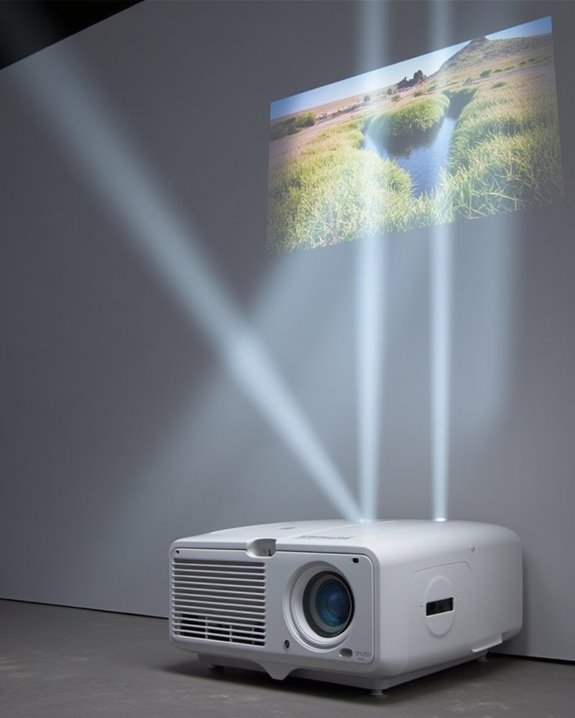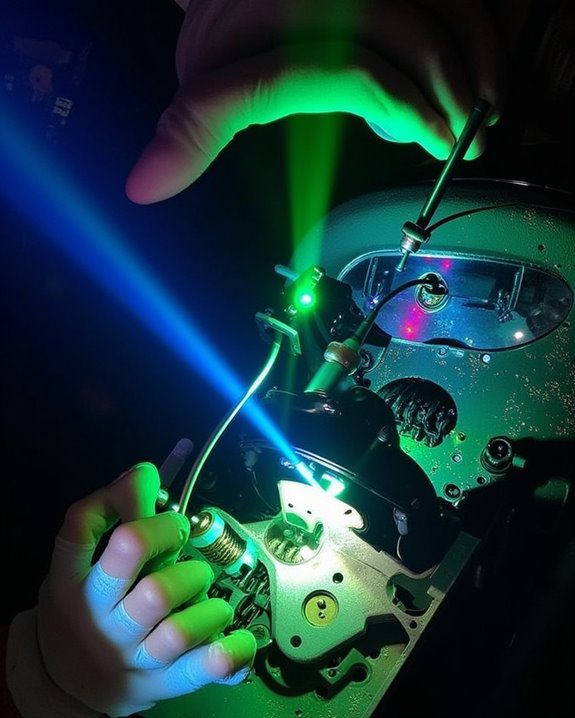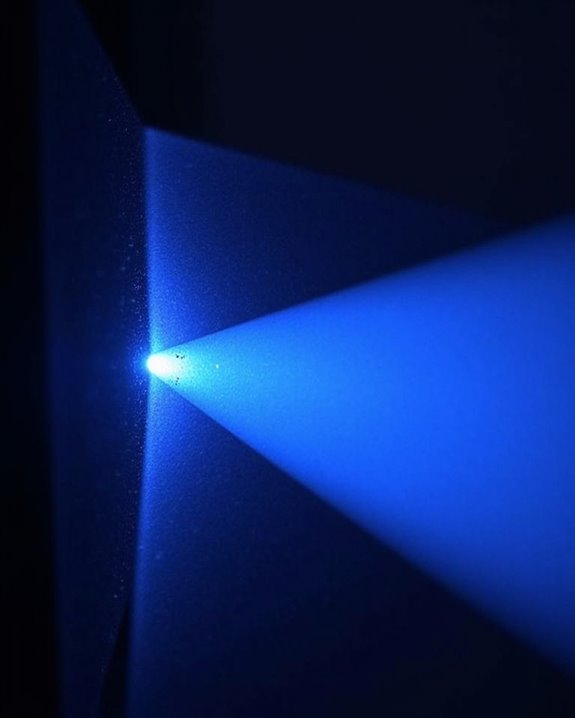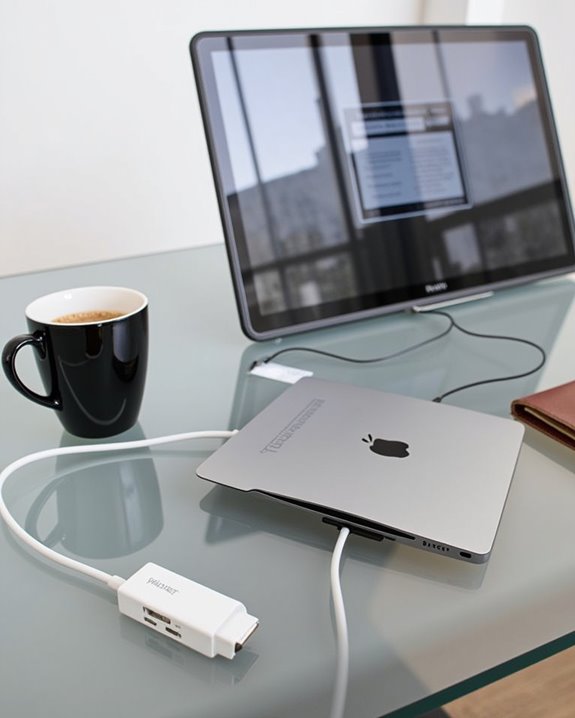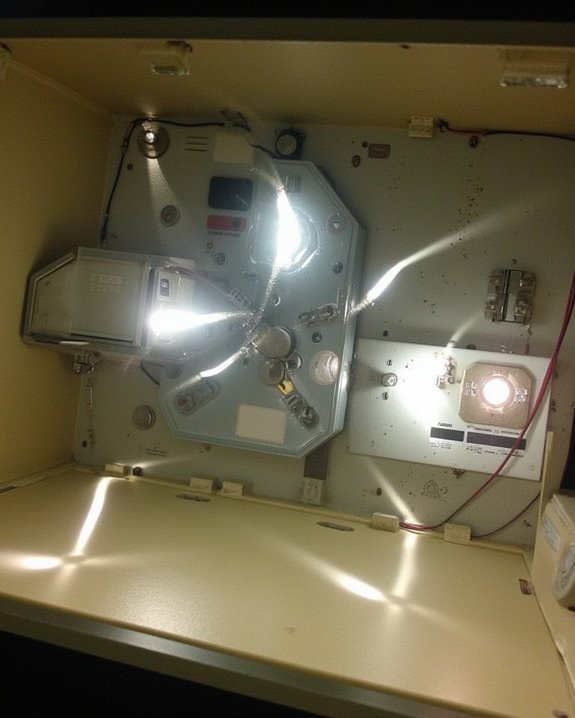When you encounter a UST projector, you’re dealing with a device engineered to project large, clear images from a remarkably short distance, often just a few inches from the screen or wall, which minimizes shadows and space requirements. These projectors use specialized lenses and mirrors to fold the light path, allowing for installation in tight spaces without sacrificing image quality. To fully appreciate how this technology changes your viewing experience, it’s important to explore its core features and design principles.
Key Takeaways
- UST (Ultra Short Throw) projectors can project large images from just a few inches away from the screen or wall.
- They use advanced lenses and mirrors to fold the optical path, enabling space-saving installation and minimal keystone distortion.
- UST projectors often feature high brightness, 4K resolution, and laser or LED light sources for long lifespan and vivid image quality.
- These projectors are ideal for small rooms or high ambient light environments, especially when paired with specialized ALR screens.
- UST projectors offer smart features, easy setup, and eliminate shadows and glare, making them great for home entertainment and flexible spaces.
Defining Ultra Short Throw Projectors
Although traditional projectors typically need a significant distance from the screen to create large images, ultra short throw (UST) projectors are specifically designed to deliver expansive displays from just a few inches away. You’ll find that UST projectors can project a 100-inch image from as close as 3 to 20 inches from the screen, unlike standard models that require 8 feet or more. This flexibility means you won’t need large, open spaces behind the projector, making UST devices ideal for tight environments. With a throw ratio generally less than 0.4, these projectors are positioned near the wall or screen, which eliminates shadows caused by people or objects moving in front. Using an optimal screen size and surface designed for UST projection can significantly enhance image clarity and brightness. Throw distance affects image size and projector placement, which makes UST technology especially beneficial for maximizing screen size in smaller rooms. This placement provides a clear, uninterrupted viewing experience in classrooms, meeting rooms, and home theaters alike.
Key Features of UST Projectors
When you’re considering a UST projector for your space, it’s important to understand the core features that set these devices apart from standard projectors, especially regarding performance, light source technology, smart capabilities, installation flexibility, and audio enhancements. UST projectors often deliver high brightness—such as 1800 ISO lumens—along with 4K UHD resolution, high contrast ratios like 3000:1, and low input lag for gaming, ensuring clear, vibrant, and smooth visuals. Many also incorporate auto keystone correction to simplify setup and optimize image alignment. Most use laser light sources, providing long life, consistent brightness, reduced maintenance, and improved heat management compared to lamp-based systems. Pairing UST projectors with specialized Ambient Light Rejecting (ALR) screens can significantly boost image quality in well-lit rooms, making them suitable for a variety of indoor lighting conditions. Smart features include integrated streaming apps, voice control, wireless connectivity, and support for multiple devices. Compact design, minimal projection distance, and built-in speakers further enhance convenience, making UST projectors ideal for modern home theaters.
How UST Projectors Work: Optical Design Explained
To understand how UST projectors deliver large, sharp images from just inches away, you need to look at their specialized optical design, which uses a combination of advanced lens systems and carefully positioned mirrors. Inside, a refractive lens system works with a concave mirror to fold the optical path, allowing light to travel a shorter distance while maintaining image size and clarity. Freeform mirrors and negative distortion lenses play a pivotal role in correcting image warping caused by the ultra-short throw angle, ensuring straight lines and minimizing keystone distortion. Light from laser or LED sources is directed through these optics, passing over digital micromirror devices or liquid crystal panels for image formation. Precise alignment and robust thermal management maintain uniform brightness and Full HD resolution at close range. Additionally, high contrast ratios are essential in UST projectors to deliver vibrant colors and deep blacks despite the compact optical path. Non-uniform temperature inside the projector can impact the stability of the optical module, so effective thermal design is critical to prevent image degradation and ensure consistent performance.
Installation and Setup Flexibility
Because ultra-short throw (UST) projectors are designed to deliver large images from only inches away, you’ll find they offer significant installation and setup flexibility compared to traditional projection systems. UST projectors require minimal space, making them ideal for smaller rooms or multi-purpose spaces where maximizing every square foot is important. Their short throw distance eliminates the need for ceiling mounts or long cables, reducing installation complexity and time, while also minimizing shadows and glare. You can adapt the projector’s placement to suit various room layouts, allowing for flexible furniture and seating arrangements. However, for best results, you’ll need a flat, evenly colored wall or a specialized UST screen to prevent image distortion, and some attention to ambient lighting conditions for maintaining image quality and clarity. Many traditional projectors offer lens shift capabilities, which allow for more flexible vertical placement, but UST projectors achieve flexibility primarily through their unique throw design rather than adjustable lenses.
Home Entertainment Benefits of UST Projectors
Although traditional home entertainment setups often rely on large televisions that take up significant space, ultra-short throw (UST) projectors offer a more space-efficient solution by projecting expansive images just inches from the wall, making them ideal for compact rooms or apartments. UST projectors deliver large, high-quality images while minimizing glare and shadows, creating an immersive viewing experience in a range of lighting conditions. Their compact design supports easy placement in different room layouts, and advanced ambient light management helps maintain vivid color and contrast. Many models include smart features such as built-in streaming services, voice control, and seamless device compatibility, enhancing both movie nights and gaming sessions. With cost-effective screen size versatility and durable laser technology, UST projectors present a future-proof investment for home entertainment. Additionally, laser light sources last up to 20,000 hours, which means UST projectors require far less maintenance and have a much longer usable lifespan than traditional lamp-based projectors.
Comparing UST Projectors to Traditional Models
While UST projectors offer significant advantages for home entertainment in compact spaces, understanding how they compare to traditional projector models can help you make a more informed choice for your setup. UST projectors use complex lenses to display large, 100-inch images from less than a foot away, making them ideal for small rooms where space is limited, though they often require specialized screens for best image quality. In contrast, traditional projectors project from several feet away, work with a wider variety of screens, and usually provide superior contrast ratios, but they need more installation space. UST models generally come at a higher cost due to their advanced optics and smart features, while traditional projectors are more affordable and flexible in placement, especially for larger rooms. Rooms with high ambient light benefit from pairing UST projectors with ALR screens, which help maintain bright and clear images even during daytime viewing.
Frequently Asked Questions
How Do You Clean and Maintain a UST Projector?
To clean and maintain your UST projector, power it down, let it cool, and use a soft brush and microfiber cloth. Clean the lens gently in circles, avoid harsh chemicals, inspect regularly, and always store it dust-free.
What Types of Screens Work Best With UST Projectors?
Did you know some UST projector screens can reach up to 150 inches? You’ll want CLR or ALR screens—especially Fresnel or Lenticular types—since they block ambient light, boost contrast, and are available for different budgets and setups.
Are UST Projectors Suitable for Outdoor Use?
You’ll find UST projectors can work outdoors, especially if you pick a weather-resistant, bright model with a strong sound system. Just make sure you’ve got enough brightness to overcome sunlight and use proper weather protection.
Can UST Projectors Be Used for Gaming?
You probably thought projectors were just for movies—guess again! If you want massive, immersive gaming visuals and don’t mind spending extra for low input lag and high refresh rates, UST projectors can seriously level up your setup.
What Is the Typical Lifespan of a UST Projector’S Light Source?
You’ll find a UST projector’s light source typically lasts 20,000 to 30,000 hours, thanks to laser technology. With daily use, you can expect up to 12 years of performance, especially if you maintain it properly.

